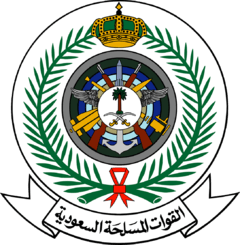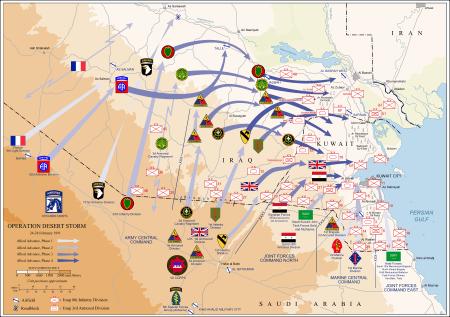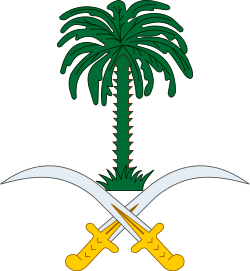Armed Forces of Saudi Arabia
The Royal Saudi Arabian Armed Forces (Arabic: القُوّات المُسَـلَّحَة السُّـعُوديَّة; Arabic pronunciation: [al-Quwwāt al-Musallaḥah as-Suʿūdiyyah]) consists of the Saudi Arabian Army, the Royal Saudi Air Force, the Royal Saudi Navy, the Royal Saudi Air Defense, and the Royal Saudi Strategic Missile Force.
In addition the Saudi Arabian National Guard (SANG), which is one of the three major branches of the Joint Forces of the Kingdom. The national guard is under the administrative control of the Ministry of National Guard, instead of the Ministry of Defence, the Saudi Arabian Royal Guard, and paramilitary forces.
Kingdom of Saudi Arabia has one of the best-funded defence forces in the Middle East. The kingdom spends 25% of its budget, or about $88 billion,[14] on its military. In terms of manpower, Saudi Arabia has about 688,000 active personnel in its military, with 300,000 army troops.[18] Saudi Arabia also has more than 200,000 men in its national guard[19] and 25,000 tribal levies,[20] which is used primarily to secure internal threats but has been used as an expeditionary force too. The navy has about 60,000 members,[21] air defense forces and strategic rocket forces about 40,000 soldiers. In addition to the air forces with more than 63,000 active employees,[22] also there is a military intelligence service, the General Intelligence Presidency (GIP).
The Saudi Arabian National Guard is not a reserve but a fully operational front-line force, and originated out of Abdul Aziz's tribal military-religious force, the Ikhwan. Its modern existence, however, is attributable to it being effectively Abdullah's private army since the 1960s and, unlike the rest of the armed forces, is independent of the Ministry of Defense. The SANG has been a counterbalance to the Sudairi faction in the royal family; Salman bin Abdul-Aziz Al Saud, the king, is one of the so-called "Sudairi Seven" and controls the remainder of the armed forces.[23]
Armed services
The armed forces are mainly the responsibility of the Ministry of Defense and Aviation, which also oversees the construction of civilian airports as well as military bases, and meteorology departments.
Crown Prince Sultan bin Abdulaziz was Saudi Arabia's Minister of Defence and Aviation from 1962 to 2011. The vice minister, Abdulrahman bin Abdulaziz, was his full brother, and served until November 2011. His oldest son, Khalid bin Sultan, was appointed assistant minister in 2001 and was in office until April 2013.
In 1987, members of the air force, army, and navy are mainly recruits from groups of people without a strong identity from the Nejd tribal system and people from urban areas.[24]
Defense spending
Spending on defense and security has increased significantly since the mid-1990s and was about US$67 billion in 2013. Saudi Arabia ranks among the top five nations in the world in government spending for its military, representing about 9% of GDP in 2013. Its modern, high-technology arsenal makes Saudi Arabia among the world's most densely armed nations, with its military equipment being supplied primarily by the United States, France, and Britain.[25] According to SIPRI, in 2010–14 Saudi Arabia became the world's second largest arms importer, receiving four times more major arms than in 2005–2009. Major imports in 2010–14 included 45 combat aircraft from the UK, 38 combat helicopters from the USA, 4 tanker aircraft from Spain and over 600 armoured vehicles from Canada. Saudi Arabia has a long list of outstanding orders for arms, including 27 more combat aircraft from the UK, 154 combat aircraft from the USA and a large number of armoured vehicles from Canada.[26]
The United States sold more than $80 billion in military hardware between 1951 and 2006 to the Saudi military.[27] In comparison, the Israel Defense Forces received $53.6 billion in U.S. military grants between 1949 and 2007.[28] On 20 October 2010, U.S. State Department notified Congress of its intention to make the biggest arms sale in American history—an estimated $60.5 billion purchase by the Kingdom of Saudi Arabia. The package represented a considerable improvement in the offensive capability of the Saudi armed forces.[29] The United States emphasized that the arms transfer would increase "interoperability" with U.S. forces. In the 1990–1991 Gulf War, having U.S.-trained Saudi forces, along with military installations built to U.S. specifications, allowed the American armed forces to deploy in a comfortable and familiar battle environment. This new deal would increase these capabilities, as an advanced American military infrastructure is about to be built.[30] The U.S. government was also in talks with Saudi Arabia about the potential sale of advanced naval and missile-defense upgrades.[31]
The UK has also been a major supplier of military equipment to Saudi Arabia since 1965.[32] Since 1985, the UK has supplied military aircraft—notably the Tornado and Eurofighter Typhoon combat aircraft—and other equipment as part of the long-term Al-Yamamah arms deal estimated to have been worth £43 billion by 2006 and thought to be worth a further £40 billion.[33]
Canada recently won a contract worth at least US$10 billion to supply the Saudi Arabian army with armored military vehicles.
Army

The army's main equipment consists of a combination of French- and U.S.-made armored vehicles: 315 M–1A2 Abrams, 290 AMX–30, and 450 M60A3 main battle tanks; 300 reconnaissance vehicles; 570+ AMX–10P and 400 M–2 Bradley armored infantry fighting vehicles; 3,000+ M113 and 100 Al-Fahd armored personnel carriers, produced in Saudi Arabia; 200+ towed artillery pieces; 110 self-propelled artillery pieces; 60 multiple rocket launchers; 400 mortars; 10 surface-to-surface missiles; about 2,000 antitank guided weapons; about 200 rocket launchers; 450 recoilless launchers; 12 attack helicopters; 50+ transport helicopters; and 1,000 surface-to-air missiles.[25]
In 1996 Saudi Arabia had military cities in the northeast, the King Khalid Military City, at Tabuk, at Dharhran, and at Abha in the southwest. There was a 1996 report that construction of a military city at Jizan, orientated toward Yemen, had begun with Defence Minister Prince Sultan pouring the first concrete on 8 May 1996.[34]
Air Force

As of 2011, Saudi Arabia has around 300 combat aircraft. The kingdom's combat aircraft are newly acquired Typhoons and upgraded Tornado IDS, F-15 Eagle and F-15E Strike Eagle fighter planes. Saudi Arabia has a further 80+ F-15 Eagles on order and an option to buy another 72 Typhoons.
Navy

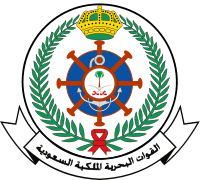
The navy's inventory includes 11 principal surface combatants, 65 patrol and coastal combatants, 7 mine warfare vessels, 8 amphibious craft, and 7 support and miscellaneous craft. Naval aviation forces have 19 helicopters (armed) serving in naval support.[25]
Air Defense
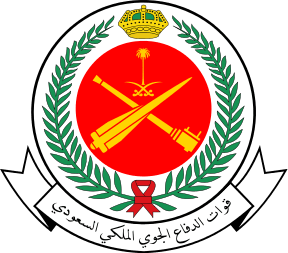
The system equipment comprises 17 General Electric AN/ FPS-117 long-range 3-D radars, 6 Northrop Grumman AN/TPS-43 tactical radars, and Raytheon Improved HAWK air defence missile system.[35]
Ballistic Missile Forces
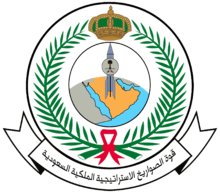
But RSSMF certainly has one advanced Al-Watah ballistic missile base (found on the satellite images) in the rocky central part of Saudi Arabia, some 200 km south-west of the capital city Riyadh.[37] Two other bases include Al Sulayyil ballistic missile base (the older base located 450 km southwest of Riyadh)[38] and Al Jufayr base (placed 90 km south of Riyadh) share many similarities, suggesting that they share the same role.
Independent Forces
SANG
The Saudi Arabian National Guard is independent of the Ministry of Defense and Aviation and is organized into three mechanized infantry brigades, five infantry brigades, and one ceremonial cavalry squadron.
The SANG is equipped with 100 Saudi-manufactured Al-Fahd infantry fighting vehicles.[39] It has been strengthened by the purchase of US$1 billion worth of new armored vehicles from Canada.
Royal Guard
The Saudi Arabian Royal Guard Regiment is one of the more visible units . Originally an independent military force, the Royal Guards were incorporated into the Army in 1964. However, the Royal Guards still retained their unique mission of protecting the House of Saud. Units of the Royal Guard protect the King of Saudi Arabia at all times.[40]
The Royal Guards report directly to the king and for security reasons maintain a separate communications network from the regular Army.
Members of the Royal Guard Regiment often wore the flowing white thaub (robe) and white kaffiyah and qutrah (traditional Arab headgear of skullcap and scarf). Royal Guardsmen wear bright green berets when in conventional uniforms.
Recent military operations
The Persian Gulf War
When Iraq invaded Saudi Arabia's northern neighbor Kuwait in 1990, Saudi Arabia immediately requested the deployment of U.S. troops within the country to deter further aggression. Saudi forces participated in the subsequent Operation Desert Storm: Saudi pilots flew more than 7,000 sorties and Saudi troops took part in the battles around the Saudi town of Raʾs al-Khafji.[41]
Operation Southern Watch
Since the Gulf War, the United States stationed 5,000 troops in Saudi Arabia, a figure that rose to 10,000 during the 2003 conflict in Iraq.[42] Operation Southern Watch enforced the no-fly zones over southern Iraq set up after 1991, as well, the country's oil exports through the shipping lanes of the Persian Gulf are protected by the United States Fifth Fleet based in Bahrain. It was conducted by Joint Task Force Southwest Asia (JTF-SWA) with the mission of monitoring and controlling airspace south of the 32nd Parallel (extended to the 33rd Parallel in 1996) in Iraq, following the 1991 Persian Gulf War until the 2003 invasion of Iraq.
This was one of the stated motivations behind the September 11th terrorist attacks,[42] as well as the Khobar Towers bombing.[43] Bin Laden interpreted the Islamic prophet, Muhammad as banning the "permanent presence of infidels in Arabia".[44] U.S. troops in Saudi Arabia served to provoke skirmishes between Iraq and the United States between both Persian Gulf Wars.
Shia insurgency in Yemen
On 5 November 2009, the Royal Saudi Land Forces launched a sweeping ground offensive against Yemen's Shiite Houthi rebels after they crossed the Saudi border in order to outflank the Yemeni Army, which had launched a military campaign against the Houthis to control and pacify the northern Yemeni mountains, and killed two Saudi border guards. The Saudi forces relied heavily on air power and artillery to soften the rebels without risking their men. The Saudi Army lost 133 soldiers in the fighting against the rebels, with most of the casualties occurring when ground forces tried to move into areas that had been softened by shelling. that "raised alarms across the Sunni Arab world about the Iran is supporting the Yemeni rebels".[45]
Officers
| Officers | |||||||||||
|---|---|---|---|---|---|---|---|---|---|---|---|
| Lieutenant | First Lieutenant | Captain | Major | Lieutenant Colonel | Colonel | Brigadier General | Major General | Lieutenant General | General | ||
Enlisted Ranks
| Enlisted Ranks | |||||||||||
|---|---|---|---|---|---|---|---|---|---|---|---|
| Private | Private First Class | Corporal | Vice Sergeant | Sergeant | Sergeant First Class | Master Sergeant | |||||
Ministers of the Ministry of Defence
- Abdullah bin Sulaiman Al Hamdan (24 September 1934 – 10 November 1943) (head of the predecessor Defense Agency)
- Mansour bin Abdulaziz Al Saud (10 November 1943 – 2 May 1951)
- Mishaal bin Abdulaziz Al Saud (12 May 1951 – 1953)
- Fahad bin Saud bin Abdulaziz Al Saud (1957–1960)
- Muhammed bin Saud Al Saud (1960–1963)
- Sultan bin Abdulaziz Al Saud (1963 – 22 October 2011)
- Salman bin Abdulaziz Al Saud (5 November 2011 – 23 January 2015)
- Mohammad bin Salman Al Saud (23 January 2015 – present)
Deputy Ministers
- Turki II bin Abdulaziz Al Saud (1969–1978)
- Abdul-Rahman bin Abdulaziz Al Saud (1978 – 5 November 2011)
- Khalid bin Sultan (5 November 2011 – 20 April 2013)
- Fahd bin Abdullah bin Mohammed Al Saud (21 April 2013 – 7 August 2013)
- Salman bin Sultan (6 August 2013 – 14 May 2014)
- Khalid bin Bandar Al Saud (14 May 2014 – 28 June 2014)
Military industry
The vast majority of Saudi Arabia's military equipment is imported from European and North American suppliers.[25] However, the Al-Fahd Infantry fighting vehicle and the Al-Faris 8–400 armored personnel carrier, used by Saudi land forces, were manufactured by the Abdallah Al Faris Company for Heavy Industries, based in Dammam.[46] Also, Al-Kaser and Al-Mansour armored vehicles and the Al-Masmak MRAP which has achieved very high protection, all are Saudi-made[47][48] Ashibl 1 and Ashibl 2 are Saudi-made armored vehicles used by the Royal Saudi Land Forces and the kingdom's most elite special operations units of Battalion 85. Saudi Arabia has also recently unveiled the new Tuwaiq MRAP[49][50]
See also
- King Khalid Military City
- United States Military Training Mission (USMTM)
- Office of the Program Manager, Saudi Arabian National Guard Modernization Program (OPM-SANG)
- Terrorism in Saudi Arabia
- United States withdrawal from Saudi Arabia
- Nuclear program of Saudi Arabia
- Saudi Arabian-led intervention in Yemen
References
- ↑ Sir James Norman Dalrymple Anderson. The Kingdom of Saudi Arabia. Stacey International, 1983. Pp. 77.
- ↑ al-Rasheed, Madawi (2010). A History of Saudi Arabia. ISBN 978-0-521-74754-7.
- ↑ Hertog, Steffen (2007). "Shaping the Saudi state: Human agency's shifting role in the rentier state formation" (PDF). International Journal Middle East Studies. 39: 539–563. doi:10.1017/S0020743807071073. Retrieved 17 April 2012.
- ↑ "الملك عبدالعزيز في التاريخ المعاصر"، أطروحة في كلية القيادة والأركان السعودية، سليمان العلي الشايع، 1405 ـ 1406هـ – 1985 ـ 1986م.
- ↑ "The World Factbook". www.cia.gov. Retrieved 2016-04-06.
- 1 2 "SAUDI ARMED FORCES". armedforces.eu.
- ↑ "The World Factbook". www.cia.gov. Retrieved 2016-02-11.
- ↑ كيف تبدو القوة العسكرية السعودية – بين موشينسكي
- ↑ IISS 2014, pp. 341–344
- ↑ Shrivastava, Sanskar (15 March 2011). "Saudi Arabian Troops Enter Bahrain, Bahrain Opposition Calls It War". The World Reporter. Retrieved 15 April 2011.
- ↑ Henderson, Simon. "Bahrain's Crisis: Saudi Forces Intervene". Washington Institute. Retrieved 19 March 2016.
- ↑ Felicia Schwartz, Hakim Almasmari and Asa Fitch (26 March 2015). "Saudi Arabia Launches Military Operations in Yemen". WSJ.
- ↑ "Saudi Arabia launches airstrikes in Yemen". CNN. 26 March 2015. Retrieved 26 March 2015.
- 1 2 3 "Trends in World Military Expenditure, 2015" (PDF). Stockholm International Peace Research Institute. Retrieved 5 April 2016.
- ↑ "Giri Rajendran: Russia and China drive global defence-spending increases in 2015". IIss. 9 February 2016. Retrieved 9 February 2016.
- ↑ "Archived copy". Archived from the original on 1 May 2012. Retrieved 2012-04-07. The SIPRI Military Expenditure Database
- ↑ "The SIPRI Military Expenditure Database". SIPRI. Retrieved 25 December 2014.
- ↑ "Political Regimes in the Arab World: Society and the Exercise of Power". September 4, 2012.
- ↑ "Saudi King Salman cements hold on power". aljazeera.net. 30 January 2015. Retrieved 30 January 2015.
- ↑ ", 31 December 2015,
- ↑ ", military power
- ↑ Cordesman, Anthony H.; Al-Rodhan, Khalid R. (28 June 2006). Gulf Military Forces in an Era of Asymmetric Wars (PDF). Greenwood Publishing Group. CSIS. p. 67. ISBN 978-0-275-99399-3. Retrieved 18 August 2016.
- ↑ John Pike. "Saudi Arabian National Guard". Globalsecurity.org. Retrieved 25 December 2014.
- ↑ Mackey, p. 207.
- 1 2 3 4 5 6 7 "Country Profile: Saudi Arabia", September 2006, United States Library of Congress
- ↑ "Trends in International Arms Transfer, 2014". Stockholm International Peace Research Institute. Retrieved 18 March 2015.
- ↑ "Saudi Arabia", Federation of American Scientists
- ↑ Pierre Tristam Middle East Issues Expert. "U.S. Arms Sales to Saudi Arabia". Middleeast.about.com. Retrieved 2015-11-21.
- ↑ "Arms for the King and His Family: The U.S. Arms Sale to Saudi Arabia". Jerusalem Center For Public Affairs. Retrieved 25 December 2014.
- ↑ Anthony H. Cordesman (17 September 2010). "US-Saudi Security Cooperation, Impact of Arms Sales". Saudi-U.S. Relations Information Service.
- ↑ "Saudi Arms Deal Advances", Wall Street Journal
- ↑ Gardner, Charles (1981). British Aircraft Corporation. A history by Charles Gardner. B.T. Batsford Ltd. pp. 224–249. ISBN 0-7134-3815-0.
- ↑ O'Connell, Dominic (20 August 2006). "BAE cashes in on £40bn Arab jet deal". The Sunday Times. London. Retrieved 22 August 2006.
- ↑ James Bruce, "Saudis building military city on Yemen border", Jane's Defence Weekly, 15 May 1996, p.3
- 1 2 "Peace Shield (Saudi Arabia), Systems", Jane's Military Communications, 5 July 2005 Retrieved 2012-01-23
- ↑ SinoDefence "DongFeng 3 (CSS-2) Intermediate-Range Ballistic Missile", sinodefence, 27 February 2009.
- ↑ Sean O'Connor, "Saudi ballistic missile site revealed", IHS Jane's Defence Weekly, 10 July 2013.
- ↑ Ronen Bergman, "Al Sulayyil Missile Base", GlobalSecurity.org.
- ↑ "Al Fahd – Wheeled Armoured Reconnaissance/Personnel Carrier". Army Technology. Retrieved 30 August 2010.
- ↑ John Pike (30 October 2002). "Royal Saudi Land Forces". Globalsecurity.org. Retrieved 2015-11-21.
- ↑ "Saudi Arabia". Encyclopedia Britannica. Retrieved 25 December 2014.
- 1 2 "US pulls out of Saudi Arabia". BBC News. 29 April 2003. Archived from the original on 6 January 2010. Retrieved 29 November 2009.
- ↑ Plotz, David (2001) "What Does Osama Bin Laden Want?", Slate
- ↑ Bergen, Peter L. (2001). Holy War Inc. Simon & Schuster. p. 3.
- ↑ Robert F. Worth (26 October 2010). "Saudi Border With Yemen Is Still Inviting for Al Qaeda". New York Times.
- ↑ "Weapons made in Saudi Arabia" at GlobalSecurity.org
- ↑ "Al-Masmak Masmak Nyoka Mk2 MRAP Mine Resistant Armored Personnel Carrier technical data sheet". Army Recognition. Archived from the original on 21 June 2014. Retrieved 25 December 2014.
- ↑ "Photos & Videos". www.arabic-military.com. Retrieved 25 December 2014.
- ↑ "Saudi Made "Tuwaiq" MRAP Unvieled in IDEX 2013". Retrieved 25 December 2014.
- ↑ "Saudi Twaiq Mine-Resistant Ambush Protected (MRAP)". Global Military Review. Retrieved 25 December 2014.
China, Russia, Saudi Arabia Boosted Defense Most as U.S. Cut http://bloom.bg/1OqdP38
Further reading
- "Foreign Military Sales, Foreign Military Construction Sales and Military Assistance Facts as of September 2003," Published by Deputy for Operations and Administration, Business Operations/Comptroller, DSCA, Department of Defense
- "'Chief dismissed in reshuffle,' – Chief of General Staff Lt Gen Mohammed Saleh Al-Hammad replaced by Saleh Ibn Ali Al-Mohaya," Jane's Defence Weekly, 9 October 1996, p. 23
- C. A. Woodson, "Saudi Arabian Force Structure Development in a Post Gulf War World", Foreign Military Studies Office, June 1998, http://fmso.leavenworth.army.mil
External links
- Ministry of Defense and Aviation, official website
- Royal Saudi Land Forces, official website
- Saudi Arabian National Guard, official website
- Strategic Missiles Force, official website
- General Intelligence Presidency, official website
- The Royal Saudi Air Force – A Paper Tiger, Minus the Tiger
